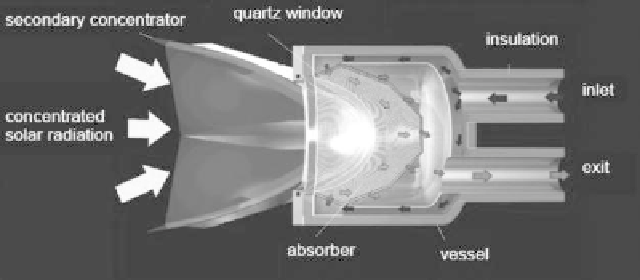Environmental Engineering Reference
In-Depth Information
Figure 14.3.23
Receiver cavity for air heating in a gas turbine engine.
conditions the net power output of the engine is expected to be equal to 75 kW with a
cycle efficiency of 47%.
14.4 HEAT TRANSFER FLUIDS AND STORAGE
This section focuses on the heat transfer fluids used in concentrated solar power plants
and on the thermal energy storage systems. The HTFs collect solar energy in the solar
field and transfer it to the power block where it is converted into electricity. Part of
this energy can be stored in the TES, hence decoupling the solar radiation from the
power production with advantages for the dispatchability of the electricity.
The HTFs from the solar field can be directly used in a turbine to produce power, in
this case also becoming the working fluid of the thermodynamic cycle (direct configura-
tion). Alternatively, the fluid can be used to transfer heat to the working fluid through
heat exchangers (indirect configuration). In this second case the fluid circulating in the
solar receiver can be properly referred to as heat transfer fluid.
Direct configuration
, for example, occurs when water is evaporated and super-
heated inside the absorber tubes of linear collectors or within the receiver of solar
tower systems. The resulting system is defined as a direct steam generation (DSG)
plant. Because of the high pressure required, as well as related control issues, this
technology has so far been applied in only a few commercial plants. DSG plants have
occasionally been applied to central receiver towers or to Fresnel reflector systems
producing saturated steam. Parabolic trough DSG plants have recently been studied in
the DISS project at the “Plataforma Solar de Almeria'' producing superheated steam
at 400
◦
C/100 bar.
Other direct configuration plants are based on compressed gas, heated inside the
receiver and then expanded in a gas turbine (central receiver) or in a Stirling engine
(solar dish).
Indirect configuration with HTF
is the commonly used configuration in most com-
mercial solar plants. Heat transfer fluids are employed in parabolic troughs, in linear
Fresnel reflectors or in central receiver plants as well. In all these systems HTF circulates

Search WWH ::

Custom Search